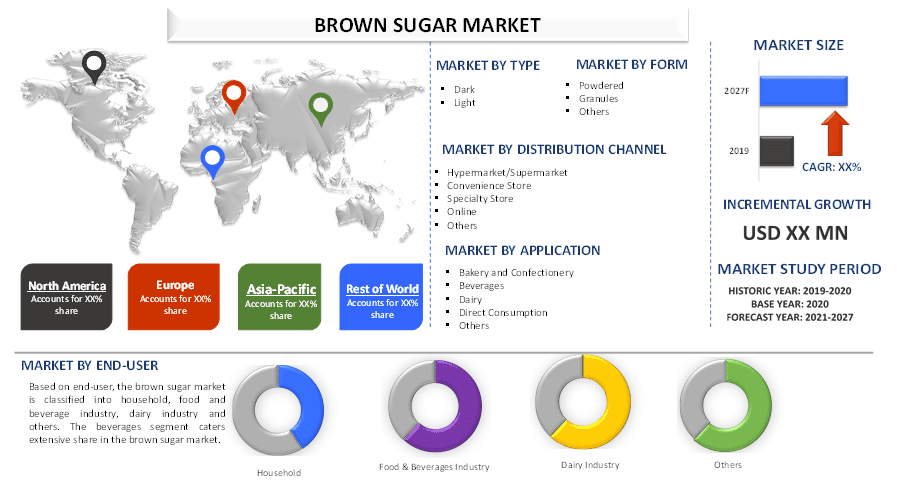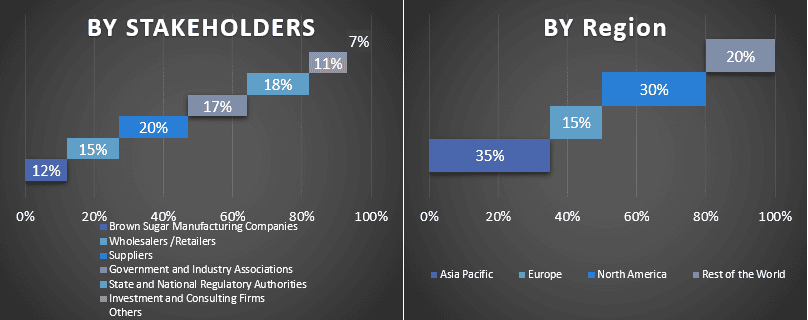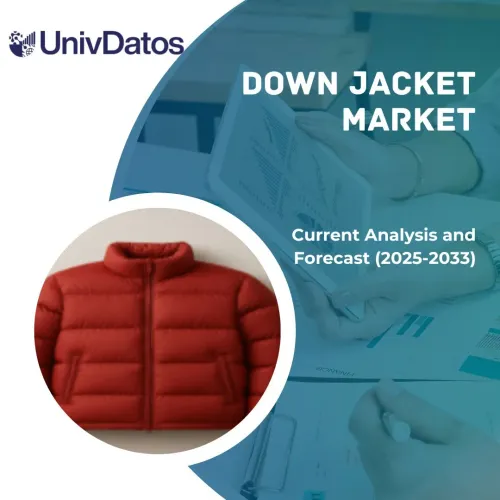- Home
- About Us
- Industry
- Services
- Reading
- Contact Us
Brown Sugar Market: Current Analysis and Forecast (2021-2027)
Emphasis on Type (Dark and Light); Form (Powdered, Granules, and Others); Distribution Channel (Hypermarkets/Supermarkets, Convivence Stores, Specialty Store, Online, and Others); By Application (Bakery and Confectionary, Beverages, Dairy, Direct Consumption and Others); End-User (Household, Food and Beverage Industry, Dairy Industry and Others); and Region and Country

Global brown sugar market expected to grow at a CAGR of around 10% during the forecast period (2021-2027). Brown sugar is a type of sugar (sucrose) that gains a brown color due to the presence of molasses. Brown sugar can either be commercially or naturally produced, with the former made by molasses being added to traditional white sugar, composing between 4% and 7% of the final product. Brown sugar is generally healthier than white sugar due to the molasses it contains. Moreover, brown sugar offers only slightly more nutrients than white sugar. It contains calcium, potassium, iron, and magnesium, and a high concentration of carbohydrates, more than 97% by weight. It also offers some benefits such as it boosts energy levels, prevent cold, treat uterine infections, improve digestion, reduce flatulence, and aid in weight loss. Moreover, with the evolving lifestyle, changing dietary patters and changing buyer inclinations are the elements boosting the development of the worldwide brown sugar market. However, increasing inclination of consumers towards sugar free products and increasing health concerns such as heart diseases, diabetes, obesity, and others are likely to restrain the growth of brown sugar market.
The coronavirus pandemic declared as public health emergency worldwide by World Health Organization (WHO). The brown sugar demand was disrupted across the countries due to the closure of industrial and commercial sector. The lockdown across various nations had stopped the functioning of restaurants, hotels, lounges, bakeries which reduced the demand for brown sugar.
Moreover, patients with diabetes were at high risk of getting infected during the Pandemic. Hence, consumers were maintaining their blood sugar levels and controlling sugar intake which has also significantly impacted the market size of brown sugar market. In addition, end-user industries such as cosmetic industry, food and beverage industry, bakery and others were also negatively influenced by the Coronavirus due to the disruption in supply chain, manufacturing and production process were stopped. As industries were working in low-capacity workforce which reduce efficiency and quantity of the product. Also, government-imposed import and export restrictions owing to the travelling ban. Hence, impacted the industry outlook.
Some of the major players operating in the market are Sudzucker, Tate & Lyle, Imperial Sugar, Nordic Sugar A/S, C&H Sugar, American Crystal Sugar, Cargill, Domino Sugar, Taikoo, ASR Group. Several M&As along with partnerships have been undertaken by these players to facilitate customers with hi-tech and innovative products/technologies.
Insights Presented in the Report
“Amongst type, dark brown sugar segment holds the major share”
Based on type, the brown sugar market is segmented into dark and light. The dark segment catered significant demand in brown sugar market. The expanding bakery industry worldwide is the principal consumer for brown sugar which is positively influencing the adoption of dark brown sugar. Also, dark brown sugar contains 6% molasses by weight, giving it a slightly stronger flavor.
“Amongst end-user, beverages segment holds the major share”
Based on end-user, the brown sugar market is classified into household, food and beverage industry, dairy industry, and others. The food and beverages segment caters extensive share in the brown sugar market. It is mainly due to easy incorporation of the brown sugar market into the local food and beverage industry as brown sugar and molasses have traditionally been part of the local dietary patterns.
“Asia Pacific represents one of the extensive market shares of global brown sugar Market”
For a better understanding of the market dynamics of the global Brown sugar market, a detailed analysis was conducted for different regions including Asia Pacific, North America, Europe, and Rest of the World. Asia Pacific holds the extensive market share owing to the growing sugar production and increasing inclination of consumers towards western food and beverage products.
Reasons to buy this report:
- The study includes market sizing and forecasting analysis validated by authenticated key industry experts.
- The report presents a quick review of overall industry performance at one glance.
- The report covers an in-depth analysis of prominent industry peers with a primary focus on key business financials, product portfolio, expansion strategies, and recent developments.
- Detailed examination of drivers, restraints, key trends, and opportunities prevailing in the industry.
- The study comprehensively covers the market across different segments.
- Deep dive regional level analysis of the industry.
Customization Options:
Global brown sugar market can further be customized as per the requirement or any other market segment. Besides this, UMI understands that you may have your own business needs, hence feel free to connect with us to get a report that completely suits your requirements.
Table of Content
Analyzing the historical market, estimation of the current market, and forecasting the future market of the global brown sugar market were the three major steps undertaken to create and analyze the adoption of brown sugar in major regions globally. Exhaustive secondary research was conducted to collect the historical market numbers and estimate the current market size. Secondly, to validate these insights, numerous findings and assumptions were taken into consideration. Moreover, exhaustive primary interviews were also conducted, with industry experts across the value chain of the global brown sugar market. Post assumption and validation of market numbers through primary interviews, we employed a top-down/bottom-up approach to forecasting the complete market size. Thereafter, market breakdown and data triangulation methods were adopted to estimate and analyze the market size of segments and sub-segments the industry pertains to. Detailed methodology is explained below:
Seek More Details About Research Methodology
Analysis of Historical Market Size
Step 1: In-Depth Study of Secondary Sources:
Detail secondary study was conducted to obtain the historical market size of brown sugar market through company internal sources such as annual report & financial statements, performance presentations, press releases, etc., and external sources including journals, news & articles, government publications, competitor publications, sector reports, third-party database, and other credible publications.
Step 2: Market Segmentation:
After obtaining the historical market size of the brown sugar market, we conducted a detailed secondary analysis to gather historical market insights and share for different segments & sub-segments for major regions. Major segments included in the report as type, form, distribution channel, application, and end-user. Further country-level analyses were conducted to evaluate the overall adoption of testing models in that region.
Step 3: Factor Analysis:
After acquiring the historical market size of different segments and sub-segments, we conducted a detailed factor analysis to estimate the current market size of brown sugar market. Further, we conducted factor analysis using dependent and independent variables such as increasing food and beverages and bakery industries. A thorough analysis was conducted for demand and supply-side scenarios considering top partnerships, merger and acquisition, business expansion, and product launches in the brown sugar market sector across the globe.
Request for Customization –
Current Market Size Estimate & Forecast
Current Market Sizing: Based on actionable insights from the above 3 steps, we arrived at the current market size, key players in the global brown sugar market, and market shares of the segments. All the required percentage shares split, and market breakdowns were determined using the above-mentioned secondary approach and were verified through primary interviews.
Estimation & Forecasting: For market estimation and forecast, weights were assigned to different factors including drivers & trends, restraints, and opportunities available for the stakeholders. After analyzing these factors, relevant forecasting techniques i.e., top-down/bottom-up approach was applied to arrive at the market forecast about 2027 for different segments and sub-segments across the major markets globally. The research methodology adopted to estimate the market size encompasses:
- The industry’s market size, in terms of value (US$) and the adoption rate of brown sugar market across the major markets domestically
- All percentage shares, splits, and breakdowns of market segments and sub-segments
- Key players in the global brown sugar market in terms of category offered. Also, the growth strategies adopted by these players to compete in the fast-growing market
Market Size and Share Validation
Primary Research: In-depth interviews were conducted with the Key Opinion Leaders (KOLs) including Top Level Executives (CXO/VPs, Sales Head, Marketing Head, Operational Head, and Regional Head, Country Head, etc.) across major regions. Primary research findings were then summarized, and statistical analysis was performed to prove the stated hypothesis. Inputs from primary research were consolidated with secondary findings, hence turning information into actionable insights.
Split of Primary Participants in Different Regions

Speak to Analyst –
Market Engineering
Data triangulation technique was employed to complete the overall market estimation and to arrive at precise statistical numbers of each segment and sub-segment of the global brown sugar market. Data was split into several segments & sub-segments post studying various parameters and trends in the areas of type, form, distribution channel, application, and end-user in the global brown sugar market.
The main objective of the Global Brown sugar Market Study
The current & future market trends of global brown sugar market were pinpointed in the study. Investors can gain strategic insights to base their discretion for investments from the qualitative and quantitative analysis performed in the study. Current and future market trends were determined the overall attractiveness of the market at a regional level, providing a platform for the industrial participant to exploit the untapped market to benefit as a first-mover advantage. Other quantitative goals of the studies include:
- Analyze the current and forecast market size of brown sugar market in terms of value (US$). Also, analyze the current and forecast market size of different segments and sub-segments
- Segments in the study include areas of type, form, distribution channel, application, and end-user.
- Define and analysis of the regulatory framework for the brown sugar market industry.
- Analyze the value chain involved with the presence of various intermediaries, along with analyzing customer and competitor behaviors of the industry.
- Analyze the current and forecast market size of the brown sugar market for the major region.
- Major regions studied in the report include Asia Pacific, Europe, North America, and Rest of the world.
- Company profiles of the brown sugar market and the growth strategies adopted by the market players to sustain in the fast-growing market
- Deep dive regional level analysis of the industry
Related Reports
Customers who bought this item also bought










